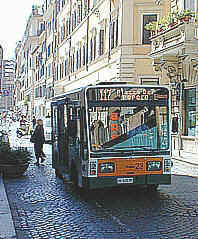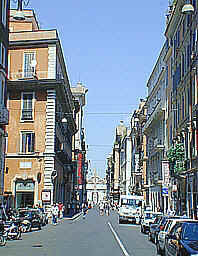

Spanish Steps quarter: Via Babuino area, Via San Giacomo, Via dei Greci, Via del CorsoFor a complete presentation, please visit the specific pages on the streets of the quarter:
Via del Babuino (Baboon Street) connects the Spanish Steps with Piazza del Popolo and the northern gate of Rome. It owes its name to an ancient Roman statue situated near the Church of St. Attanasio, at half-way of its length. The statue is warned-out, and the Romans, with their great witty personality dubbed it "the baboon", because it was ugly. Today it is part of a fountain, and it is one of the "talking statues" of Rome. Whoever has something to say, or someone to insult, will write a graffiti, or leave a written message. The Church of St. Atanasio is a Greek-Catholic church, i.e. the priests are Catholic, but they follow the oriental rite, and they can marry. |
APARTMENTS FOR RENT IN THIS QUARTER"ROME SEAGULLS": luxury panoramic penthouse, with two terraces with stunning views of all Rome, two bedrooms (matrimonial and twin beds), two sitting rooms, two sparkling bathrooms (shower enclosure and bathtub), kitchen. Remarkable equipment. Elevator. "Three Coins" (Vicolo del Forno): A one bedroom attic with ample sitting-dining room, and a panoramic patio overlooking old Rome's roofs and the Trevi Fountain (2-3 persons). "Valentino" (Via Sistina): an upscale panoramic topfloor apt., with master bedroom, sitting room, separate dining room, two bathrooms, a patio and a large terrace overlooking all Rome (2-3 persons). "Leonardo" (Via della Croce), a three bedroom, sitting room, 2 bathrooms, terrace apartment in an 18th century palazzo (2-6 persons). "Anita" (Via delle Carrozze): a large upscale suite with three bedrooms, sitting-dining room, three bathrooms, large kitchen, remarkably equipped (3-6 persons). "Regina" (Via San Giacomo): a large upscale suite with three bedrooms, sitting room, separate dining room, three bathrooms, large roof garden, balconies (3-6 persons). |
|||||||||||||||||||||||||||||||||||||||||||
Just after it you find one of the two Anglican Church in Rome, St. Patrick. The little streets intersecting the Via del Babbuino are famous, although they have a different personality. Via dei Greci is renowned for its antiquaries, for the Lyon Bookshop (the oldest English bookshop in Rome, and for the famous Musical Academy of Santa Cecilia. Via Margutta is famous for its artists' and painters' studios.
Via Orto di Napoli is known for its charm, Via San Giacomo, where circulation is forbidden (cars can only park), has a very special feel for its quiet and its mannerly palaces. Luckily, it includes also a grammar school, with only a few students, which make it somewhat lively in certain hours of the day. The street brings to the Church with the same name (San Giacomo) in Via del Corso.
Two electric buses drift among tourists in Via del Babuino. They are 117 and 119, and are very convenient to go to a number of destinations (Piazza del Popolo, the Borghese Gardens and Museum, Via del Corso, Piazza Venezia, Capitol Hill, the Roman Forum and the Monti quarter. There are countless shops in the area, notably antiquaries, art studios and galleries, and jewelers.
Many famous Italian composers studied at the Musical Academy of Santa Cecilia in Via dei Greci / Via Vittoria.
Visit Rome | Rome panoramic views | Rome apartments and villas | Inquire | Rome travel guide | Rome map | Service | Resources Roman Homes homepage |
||||||||||||||||||||||||||||||||||||||||||||















